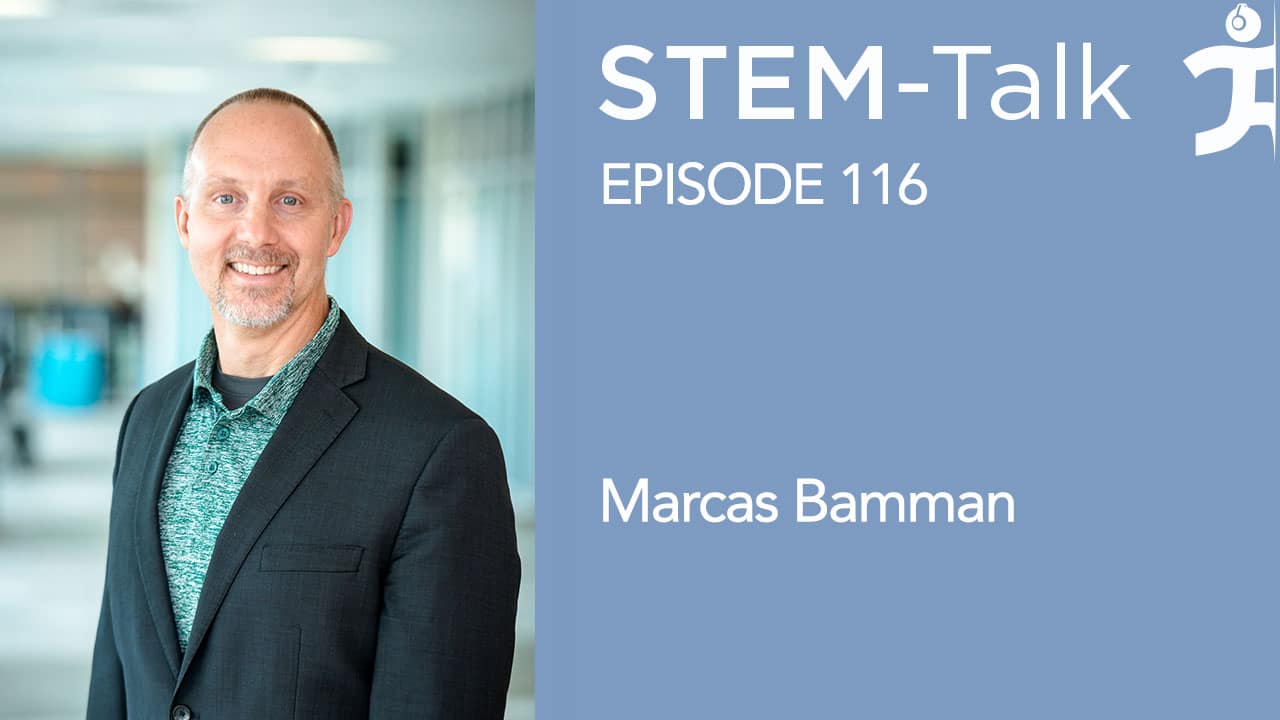STEM-Talk
Episode 116: Marcas Bamman on the many benefits of exercise and strength training
// Dec 16, 2020

Our guest today is Dr. Marcas Bamman, an internationally recognized researcher known for his scientific contributions to the biology of human skeletal muscle and medical rehabilitation.
Marcas recently joined IHMC as a Senior Research Scientist. He is the founder and former director of the University of Alabama at Birmingham Center for Exercise Medicine. Marcas and the UAB center are recognized as world leaders in the biological mechanisms underlying exercise-induced adaptations and their clinical utility in disease prevention, treatment and rehabilitation. At IHMC, he will expand his research aimed at maximizing the performance and resilience of elite warfighters.
One of Marcas’ first projects at IHMC is working with the institute’s Chief Science Officer Tim Broderick on a DARPA-sponsored program. This research is aimed at developing a revolutionary platform to enhance training and resilience of elite service members. Tim talked about the program, called the Peerless Operator Biologic Aptitude project, during his interview on episode 112 of STEM-Talk.
In today’s interview, we talk to Marcas about the Peerless project as well as his earlier research into the many ways that exercise and strength training can induce a multitude of health benefits.
Show notes:
[00:03:11] Dawn opens the interview by asking Marcas where he grew up. [00:03:21] Dawn asks Marcas what sports he played given that he is now an exercise scientist. [00:03:45] Dawn mentions that in addition to being good at basketball and soccer in high school, that Marcas was also good in his chemistry and mathematics classes. [00:04:47] Dawn asks if it is true that Marcas was the sports editor of his high school newspaper. [00:05:25] Dawn asks Marcas why he decided to pursue science despite having a promising future as a sportswriter. [00:06:08] Ken asks if Marcas decided to attend Kansas State University after high school because it was the same school his father had attended. [00:06:59] Ken asks what led Marcus to the University of Alabama Birmingham for his master’s degree. [00:08:09] Dawn asks if it is true that Marcas met his wife Deanna in a fitness center. [00:09:00] Marcas explains the non-traditional rout he took to earning his doctorate at the University of Florida. [00:14:05] Dawn mentions that while Marcas was working at NASA, he worked on a study that had people go through 14 days of bedrest in an effort to mimic space flight. The resulting paper appeared in Medicine and Science in Sports and Exercise and was titled, “Resistance Exercise Prevents Plantar Flexor Deconditioning During Bed Rest.” Dawn asks about the study and its findings, as well as how Marcas was able to convince people to spend 14 days in bed. [00:19:47] Marcas explains how he ended up back at UAB following his dissertation. [00:20:32] Ken asks what Marcas’ overarching question was that drove his research when he began his career at UAB. [00:22:24] Dawn mentions that Marcas has played a major role nationally in the recognition and growth of exercise medicine. Dawn asks how Marcas first became interested in this concept of exercise as medicine. [00:24:06] Dawn asks Marcas to talk about his research that has shown that exercise can help prevent and delay health problems, and that different types of exercise can bring about different health benefits. [00:29:38] Dawn mentions that in 2011 Marcas established the University of Alabama Birmingham Center for Exercise Medicine (UCEM), which has become well known nationally as a leader in exercise medicine. Marcas gives an overview of how the center came about and the research that is conducted there. [00:34:23] Marcas gives an overview of a clinical trial he conducted in 2011 which showed that men and women in their 60’s and 70’s who underwent supervised weight training developed muscles that were as large and strong as those of the average, untrained 35- to 40-year-old. [00:37:34] Dawn asks if there is any evidence suggesting that male and female older adults need different types of exercise training for maximal health benefits. [00:40:06] Ken asks Marcas about his research into how a person’s genetic background determines their response to exercise, which helps explain why some individuals are more naturally suited to one type of exercise over another. [00:44:42] Marcas shares that while some people may not gain as much muscle from exercise as others, everyone responds in a positive way to exercise. [00:45:56] Dawn asks if Marcas thinks there will ever be a drug developed that will give people the same kind of benefits as exercise. [00:47:12] Ken mentions that there have been some drug trials that have shown an ability to increase muscle size in older adults. He goes on to mention that these changes have not translated into functional outcomes or patient benefits. He asks if there might be a sweet-spot for people who are limited in the amount of exercise they are able to do to maximize the benefits of minimal exercise with one of these drugs. [00:48:35] Ken mentions that PPAR-delta agonists have shown substantial promise for specific populations. [00:50:10] Ken explains that there are studies suggesting that exercise can help prevent or delay the onset of Alzheimer’s. He goes on to ask, in light of all the many benefits of exercise, why doctors are not prescribing exercise as a treatment rather than merely writing drug prescriptions. [00:54:05] Dawn asks if the American Heart Association’s recommendations that people get at least 150 minutes of moderate to vigorous physical activity a week (including two days a week of moderate to high-intensity strength training) falls in line with what Marcas would recommend. [00:56:11] Dawn mentions that in 2017 Marcas published a paper looking into the dose-response effects of exercise in older individuals. Dawn asks if Marcas can elaborate on this paper and explain whether he thinks establishing an effective dose of exercise might have both scientific and practical merit. [01:01:21] Dawn explains that due to COVID-19 many people are avoiding gyms. She asks if Marcas has any recommendations for people who are struggling to keep their muscles in shape during this pandemic. [01:03:31] Ken explains that sedentary adults can lose 30 to 40 percent of the total number of fibers in their muscles by the time they are 55. This is significant because many neuromuscular and chronic inflammatory diseases are closely associated with muscle weakness, skeletal muscle atrophy, and muscle fatigue. It’s a serious issue, and one of the reasons that the NIH launched a six-year, $200-million-plus study called the NIH Molecular Transducers of Physical Activity Consortium which is targeting an enrollment of about 2,000 sedentary people and 300 highly active/trained people. Ken asks Marcas, as a part of this ambitious study, to give an overview as to how the study is being conducted and what researchers hope to learn. [01:07:49] Dawn mentions that even though the merits of exercise are well known, the biggest difficulty is getting people to maintain a healthy exercise regimen. She asks for Marcas’ opinion in regards to the balance between applied and basic science from a funding point of view and how to best maximize solving the problems associated with a lack of exercise. [01:10:18] Dawn mentions that Parkinson’s disease is the most common motor neurodegenerative disease. She goes on to mention that Marcas, earlier this year, had a paper in Frontiers in Physiology about a study that set out to identify transcriptional networks that may contribute to resistance-training-induced neuromuscular remodeling in Parkinson’s disease. Dawn also asks about Marcas’ 2014 paper that found high intensity exercise improved muscle mass, mitochondrial function and physical capacity in people with Parkinson’s. [01:15:09] Dawn mentions that with Marcas’ move to IHMC, he is transitioning from clinical populations to now working on Department of Defense-focused work. She points out that he will be taking the same sorts of questions and principles he once explored with clinical populations and now attempt to apply them to other areas. Marcas explains this transition. [01:16:58] Marcas talks about his reasons for leaving his well-established lab at UAB and coming to IHMC. [01:18:51] Ken mentions that one of Marcas’ first projects at IHMC is a DARPA-sponsored program aimed at developing a revolutionary platform to enhance training and resilience of elite service members known as the Peerless Operator Biologic Aptitude project. Marcas gives an overview of this project and his role in it. [01:22:09] Marcas talks about his recent experience taking a building on an Air Force base in San Antonio and converting it into a human-performance lab for the Peerless project. [01:24:06] Ken harkens back to Marcas’ aforementioned 2011 paper examining the adaptation in older individuals to resistance training. Ken asks in regards to this if the study looked at muscle power, which he says seems to be the worst of the muscular-function declines in older adults. [01:26:44] Dawn asks about another project that Marcas is working on, which is being sponsored by the Office of Naval Research and is called Precision High-Intensity Training Through Epigenetics, or PHITE. Dawn explains that this trial is trying to determine if the effect of exercise dose on performance optimization and the underlying molecular mechanisms of that phenomenon with a focus on epigenetics. [01:30:43] Marcas tells an interesting story about his experience of zero gravity back when he worked at NASA. [01:32:53] Marcas explains what his exercise routine consists of. [01:34:08] Dawn asks Marcas what sort of diet he follows. [01:36:14] Ken closes the interview asking Marcas about the things he likes to do when he is able to find some spare time in his busy schedule.Links:






